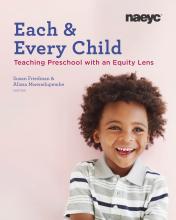Each and Every Child: Teaching Preschool with an Equity Lens

About the Book
Table of Contents
- Introduction
-
Part 1: Nurturing Your Own Empathy and Understanding Behavior
-
Chapter 1: Examining Teacher Bias | Louise Derman-Sparks and Julie Olsen Edwards, with Catherine M. Goins
- Chapter 2: Developing Empathy to Build Warm, Inclusive Classrooms | Charis L. Wahman and Elizabeth A. Steed, with Susan Friedman
- Chapter 3: Valuing Diversity: Developing a Deeper Understanding of All Young Children’s Behavior | Barbara Kaiser and Judy Sklar Rasminsky
-
-
Part 2: Creating an Equitable Classroom
- Chapter 4: Connecting Culture and Play: Practical Strategies for Educators | Kamini Kamdar
- Chapter 5: The Balancing Act of Guided Play | Brenna Hassinger-Das, Kathy Hirsh-Pasek, and Roberta Michnick Golinkoff
- Chapter 6: Welcoming Refugee Children into Early Childhood Classrooms | Sadia Warsi
- Chapter 7: Creating a Culturally Responsive STEAM Curriculum | Anthony Broughton and Michiko B. McClary
- Chapter 8: Including All Children in Making and Tinkering! | Karen N. Nemeth and Pamela Brillante
- Chapter 9: Growing Little Storytellers | Ronald F. Ferguson and Tatsha Robertson
- Chapter 10: Books that Support Diversity, Conversations, and Play | Shannon B. Wanless and Patricia A. Crawford, with Susan Friedman
-
Part 3: Developing a Strengths-Based Approach When Teaching Black Boys
- Chapter 11: Six Things You Can Do to Prevent Preschool Expulsion | Alissa Mwenelupembe
- Chapter 12: Black Boys Matter: Cultivating Their Identity, Agency, and Voice | Brian L. Wright
- Chapter 13: Black Boys Matter: Strategies for a Culturally Responsive Classroom | Brian L. Wright
-
Part 4: Supporting Emergent Bilingual Children
- Chapter 14: Supporting Emergent Bilingual Children: A Checklist for Early Childhood Educators | Shelley Pasnik and Naomi Hupert
- Chapter 15: Many Languages, One Classroom: Supporting Children in Superdiverse Settings | Carola Oliva-Olson, Linda M. Espinosa, Whit Hayslip, and Elizabeth S. Magruder
- Chapter 16: More Strategies for Supporting Children in Superdiverse Settings | Carola Oliva-Olson, Linda M. Espinosa, Whit Hayslip, and Elizabeth S. Magruder
-
Part 5: Engaging Diverse Families
- Chapter 17: Knock, Knock . . . Who's There? The Benefits of Home Visits in the Early Years | Jennifer K. Lampe
- Chapter 18: Conversations with Children! Asking Questions to Support Their Understanding of Family Diversity | Janis Strasser
- Chapter 19: When I Have a Mommy and a Mama: Including Children with All Types of Family Structures in the Classroom | Julia Luckenbill
-
Chapter 20: Advancing Equity: Playful Ways to Extend Math Learning at Home | Jessica Mercer Young and Kristen E. Reed
- Fun, Easy Ways to Play with Math at Home: A Resource for Families | Jessica Mercer Young and Kristen E. Reed
-
Part 6: Exploring Identity, Fairness, and Activism
- Chapter 21: “What If I Say the Wrong Thing?” Talking About Identity with Young Children | Nadia Jaboneta, with Deb Curtis
- Chapter 22: Pink Power and Bathroom Signs: Exploring Gender and Fairness | Jamie Solomon
- Chapter 23: “What About People Like Me?” Teaching Preschoolers About Segregation and “Peace Heroes” | Nadia Jaboneta
- Chapter 24: From Teacher to Equity Activist | Megan Pamela Ruth Madison
- References
- About the Editors
Book Details
ISBN: 978-1-938113-61-1
Publish Date: 2020
Related Resources
Position Statement
Advancing Equity in Early Childhood Education - All children have the right to equitable learning opportunities that help them achieve their full potential as engaged learners and valued members of society. Read the NAEYC's position statement on advancing equity.
Webinar
Advancing Equity: Maximizing Learning in Diverse Classrooms - Watch this recorded webinar in which Tyrone Howard and Maurice Sykes discuss practical, classroom-based strategies for teacher and child agency in the service of social and racial justice.
Looking for more resources on EQUITY? Visit our topic page to browse our collection of articles on the topic.
Enrich Your Curriculum: Purchase the Module!
Promoting equity in your classroom is within your reach, and this on-demand mini-course will give you some of the tools you need. It focuses on what equity work can look like for teachers working with children ages 3 through 5 on a day-to-day basis in the classroom. You will find strategies and tips for how you can support the learning and development of each and every child in your classroom through intentional play opportunities and guided instructional supports. This module explores the six parts of the book to supplement your teaching and start or continue your journey towards a more equitable preschool classroom.
Resources
Recommendations
For Authors & Photographers
Catalog
Webinars
NAEYC Books List
Services
Shop
Susan Friedman is senior director of publishing and content development at NAEYC. In this role, she leads the content development work of NAEYC’s books and periodicals teams. Ms. Friedman is coeditor of Each and Every Child: Teaching Preschool with an Equity Lens. She has extensive prior experience creating content on play, developmentally appropriate uses of media, and other topics for educators and families. She has presented at numerous educational conferences, including NAEYC’s Professional Learning Institute and Annual Conference, the South by Southwest Education (SXSW EDU) Conference & Festival, and the School Superintendents Association’s Early Learning Cohort. She began her career as a preschool teacher at City and Country School in New York City. She holds degrees from Vassar College and the Harvard Graduate School of Education.
Alissa Mwenelupembe is the managing director, early learning at NAEYC and works out of the DC headquarters.
Reviews
A child’s starting point matters—such an insightful and compelling message begins the journey of unpacking implicit biases in the field of early childhood. If you have been looking for a guide that operationalizes equity and shifts it into the reality of practice, this is the book for you. This is a game changer for the field of early learning.
—Marquita F. Davis, Deputy Director of Early Learning, Bill & Melinda Gates Foundation
As a society, we can and must do better to ensure all children have access to high-quality education. This resource provides concrete strategies, prompts readers with reflection questions, and sheds light on how personal biases and structural inequities impact our youngest learners. Each and Every Child will be tremendously helpful for early childhood educators, advocates, and policymakers working to achieve equity in our early childhood systems.
—Kassi Longoria, Diversity, Equity, and Inclusion Consultant, MAYA Consulting
Today’s early childhood classrooms demand attention to equity, and this book allows everyone from teachers to administrators the ability to understand why equity matters and how to embed it within the daily activities, interactions, and fabric of a program.
—Edward Manuszak, Superintendent, Dundee Community Schools
This is an essential, researched, and practical guide for empowering young children while advancing equity in the classroom. The diverse group of authors use strengths-based approaches that support identity development, engage families, and cultivate a stance for fairness and activism. Full of useful tools and strategies!
—Debbie LeeKeenan, Coauthor of From Survive to Thrive and Leading Anti-Bias Early Childhood Programs
Each and Every Child is practical, thought provoking, and a call to action. A must-read for early childhood educators committed to social justice and equity in early childhood education.
—Lorena Mancilla, Director, WIDA Early Years at the Wisconsin Center for Education Research
This book brings the NAEYC advancing equity position statement to life. Filled with stories, practical tips, and self-reflections, it is an excellent resource for all who work in the early childhood field.
—Titus DosRemedios, Director of Research and Policy, Strategies for Children
As early childhood educators, we have an obligation to embrace diversity and advance equity efforts in our profession. This book identifies the structural inequities that can interfere with a child’s learning and offers an engaging, strengths-based approach to addressing them.
—William Mosier, Director of Research, Lynda A. Cohen Center for the Study of Child Development, and Professor of Child Development, Istanbul University
This edited book by Friedman and Mwenelupembe is filled with vivid real-life scenarios, and thus it is extremely applicable and beneficial to various stakeholders who are wondering how equity-based pedagogy can be enacted with preschool age children. In response to a possible rebuttal that preschoolers are too young to be exposed to issues of equity, race, etc., Friedman and Mwenelupembe make a strong case based on recent research findings that the negative impact of implicit bias begins in early years and that young children are extremely capable of making sense of these sensitive issues.
—Excerpt from Teachers College Record review by Sophia Han
